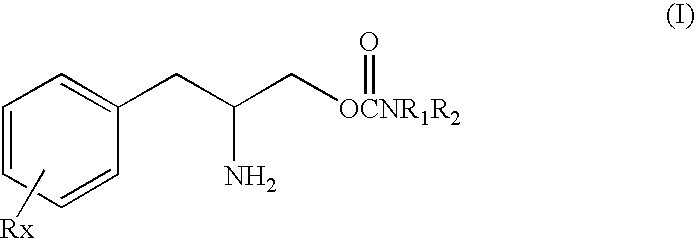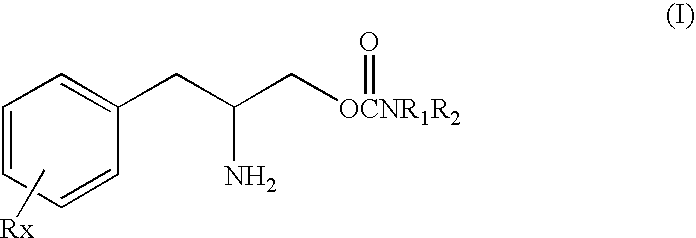Adjunctive therapy for depression
a depression and adjunctive therapy technology, applied in the field of addiction therapy for depression, can solve the problems of significant cognitive impairment, failure rate of approximately 30-40%, and many patients who do not respond to a single treatment modality
- Summary
- Abstract
- Description
- Claims
- Application Information
AI Technical Summary
Benefits of technology
Problems solved by technology
Method used
Image
Examples
Embodiment Construction
[0035]The present invention is based in part on the discovery that phenylalkylamino carbamates of Formula I have novel and unique pharmacological properties. These compounds have been shown in both animal models and in studies in humans to have anti-depressant action and to have an activating or energizing effect. Although the precise mechanism of action is not completely understood it is known that these compounds do not work as antidepressants by the same mechanisms as most other known antidepressants. For these two reasons the compounds of Formula I are especially suitable for use as adjunctive treatment for depression. Thus, these compounds can be safely used in combination with these older drugs to provide enhanced efficacy and reduced side effects because of the smaller doses of each drug that can be used.
[0036]Therefore in the methods of this invention these carbamate compounds can be added or combined in a regimen with one or more other conventional antidepressants to produc...
PUM
| Property | Measurement | Unit |
|---|---|---|
| weight | aaaaa | aaaaa |
| Resistance | aaaaa | aaaaa |
| concentrations | aaaaa | aaaaa |
Abstract
Description
Claims
Application Information
 Login to View More
Login to View More - R&D
- Intellectual Property
- Life Sciences
- Materials
- Tech Scout
- Unparalleled Data Quality
- Higher Quality Content
- 60% Fewer Hallucinations
Browse by: Latest US Patents, China's latest patents, Technical Efficacy Thesaurus, Application Domain, Technology Topic, Popular Technical Reports.
© 2025 PatSnap. All rights reserved.Legal|Privacy policy|Modern Slavery Act Transparency Statement|Sitemap|About US| Contact US: help@patsnap.com



